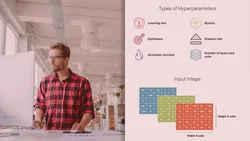
Implement Image Recognition with a Convolutional Neural Network 
This course provides an introduction to convolutional neural networks and how they can be used to implement image recognition and classification. Participants will learn how to tune and apply these networks to a business case, allowing them to take advantage of the many applications of image recognition in their daily lives. ▼
ADVERTISEMENT
Course Feature
![]() Cost:
Cost:
Free Trial
![]() Provider:
Provider:
Pluralsight
![]() Certificate:
Certificate:
Paid Certification
![]() Language:
Language:
English
![]() Start Date:
Start Date:
On-Demand
Course Overview
❗The content presented here is sourced directly from Pluralsight platform. For comprehensive course details, including enrollment information, simply click on the 'Go to class' link on our website.
Updated in [February 21st, 2023]
What does this course tell?
(Please note that the following overview content is from the original platform)
Image recognition is used in a wide variety of ways in our daily lives. This course will teach you how to tune and implement convolutional neural networks in order to implement image recognition and classification on a business case.
Image recognition has an extensive and important impact on our daily lives. From unlocking phones using facial recognition to detecting anomalies in chest-x rays, it is everywhere. In this course, Implement Image Recognition with a Convolutional Neural Network, you’ll understand how to implement image recognition and classification on your very own dataset. First, you’ll be introduced to the problem and dataset. Then, you’ll learn how to explore and prepare the dataset for the next step. Next, you’ll see how to build, train, and test a neural network on the dataset. Finally, you’ll explore how image augmentation and transfer learning help to lift the performance metrics involved in your solution. When you’re finished with this course, you’ll have the knowledge required to implement image recognition on any dataset of your choice.
We consider the value of this course from multiple aspects, and finally summarize it for you from three aspects: personal skills, career development, and further study:
(Kindly be aware that our content is optimized by AI tools while also undergoing moderation carefully from our editorial staff.)
This course, Implement Image Recognition with a Convolutional Neural Network, is designed to help learners understand the fundamentals of image recognition and classification. Learners will gain an understanding of how to explore and prepare a dataset for image recognition, build, train, and test a neural network, and explore how image augmentation and transfer learning can help to improve the performance of the model. Learners will also gain an understanding of the different technologies and algorithms used in image recognition, such as convolutional neural networks, computer vision, and image recognition algorithms. By the end of the course, learners will have the knowledge and skills necessary to implement image recognition on any dataset of their choice.
[Applications]
Upon completion of this course, Implement Image Recognition with a Convolutional Neural Network, learners will have the knowledge and skills necessary to apply image recognition and classification to their own datasets. Learners will be able to explore and prepare datasets, build, train, and test neural networks, and use image augmentation and transfer learning to improve performance metrics.
[Career Paths]
1. Machine Learning Engineer: Machine learning engineers are responsible for developing and deploying machine learning models. They are responsible for building, training, and testing models, as well as deploying them into production. They must have a strong understanding of the underlying algorithms and techniques used in image recognition and classification. As the demand for image recognition and classification increases, the need for machine learning engineers with expertise in this area will also increase.
2. Computer Vision Engineer: Computer vision engineers are responsible for developing and deploying computer vision algorithms. They must have a strong understanding of the underlying algorithms and techniques used in image recognition and classification. As the demand for image recognition and classification increases, the need for computer vision engineers with expertise in this area will also increase.
3. Data Scientist: Data scientists are responsible for analyzing and interpreting data to gain insights and make predictions. They must have a strong understanding of the underlying algorithms and techniques used in image recognition and classification. As the demand for image recognition and classification increases, the need for data scientists with expertise in this area will also increase.
4. Artificial Intelligence Engineer: Artificial intelligence engineers are responsible for developing and deploying artificial intelligence algorithms. They must have a strong understanding of the underlying algorithms and techniques used in image recognition and classification. As the demand for image recognition and classification increases, the need for artificial intelligence engineers with expertise in this area will also increase.
Course Provider

Provider Pluralsight's Stats at AZClass
Pluralsight ranked 16th on the Best Medium Workplaces List.
Pluralsight ranked 20th on the Forbes Cloud 100 list of the top 100 private cloud companies in the world.
Pluralsight Ranked on the Best Workplaces for Women List for the second consecutive year.
AZ Class hope that this free trial Pluralsight course can help your Computer Vision skills no matter in career or in further education. Even if you are only slightly interested, you can take Implement Image Recognition with a Convolutional Neural Network course with confidence!
Discussion and Reviews
0.0 (Based on 0 reviews)
Explore Similar Online Courses

The Basics of Print Design

How To Draw Faces Female Heads: Front Side & Three Quarter View

Python for Informatics: Exploring Information

Social Network Analysis

Introduction to Systematic Review and Meta-Analysis

The Analytics Edge

DCO042 - Python For Informatics

Causal Diagrams: Draw Your Assumptions Before Your Conclusions

Whole genome sequencing of bacterial genomes - tools and applications

Introduction to Computer Vision

Learn Computer Vision with OpenCV Library using Python


Start your review of Implement Image Recognition with a Convolutional Neural Network